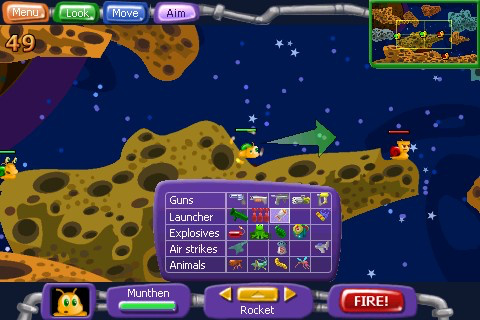

Heinlein's 1940 story " Solution Unsatisfactory" posits radioactive dust as a weapon that the US develops in a crash program to end World War II the dust's existence forces drastic changes in the postwar world. In the aftermath of World War I, the use of chemical weapons, particularly poison gas, was a major worry, and was often employed in the science fiction of this period, for example Neil Bell's The Gas War of 1940 (1931). The use of radiological, biological, and chemical weapons is another common theme in science fiction. Cleve Cartmill predicted a chain reaction-type nuclear bomb in his 1944 science-fiction story " Deadline", which led to the FBI investigating him, due to concern over a potential breach of security on the Manhattan Project.
WORMS ARMAGEDDON WEAPONS HACKED FREE
Wells' The World Set Free (1914), when scientists had discovered that radioactive decay implied potentially limitless energy locked inside of atomic particles (Wells' atomic bombs were only as powerful as conventional explosives, but would continue exploding for days on end). The phrase "atomic bomb" predates their existence, and dates back to H. Nuclear weapons are a staple element in science-fiction novels. Weapons using plasma (high-energy ionized gas) have been featured in a number of fictional universes. The most notable are Allied units Prism Tank from Red Alert 2 and Athena Cannon from Red Alert 3, the Nod's Avatar and Obelisk of Light from Tiberium Wars, as well as various units from Generals constructed by USA faction, including their "superweapon" particle cannon. In the Command & Conquer video game series, various factions make extensive use of laser and particle-beam technology. The Eldar has a special unit called the Swooping Hawks equipped with a "lasblaster". In the Warhammer 40,000 franchise, a faction known as the Imperial Guard has a "lasgun", which is described as being a handheld laser weapon, as their main weapon, and larger cannon versions being mounted onto tanks and being carried around by Space Marines. These names ranged from the generic " pulse rifle" to series-specific weapons, such as the phasers from Star Trek. īy the late 1960s and 1970s, as the laser's limits as a weapon became evident, the raygun began to be replaced by similar weapons with names that better reflected the destructive capabilities of the device.

WORMS ARMAGEDDON WEAPONS HACKED SERIES
For instance, characters in the Star Trek pilot episode The Cage (1964) and in the Lost in Space TV series (1965–1968) carried handheld laser weapons. Īfter the invention of the laser in 1960, it briefly became the death ray of choice for science-fiction writers. Clarke envisaged particle beam weapons in his 1955 novel Earthlight, in which energy would be delivered by high-velocity beams of matter. Wells also prefigured modern armored warfare with his description of tanks in his 1903 short story " The Land Ironclads", and aerial warfare in his 1907 novel The War in the Air.Ī laser tank weapon in a 1939 edition of Amazing StoriesĪrthur C.

Early science-fiction film often showed raygun beams making bright light and loud noise like lightning or large electric arcs. The discovery of X-rays and radioactivity in the last years of the 19th century led to an increase in the popularity of this family of weapons, with numerous examples in the early 20th century, such as the disintegrator rays of George Griffith's future-war novel The Lord of Labour (1911).

A very early example of a raygun is the Heat-Ray featured in H. Ī classic science-fiction weapon, particularly in British and American science-fiction novels and films, is the raygun. Examples of such weapons include Jules Verne's "fulgurator" and the "glass arrow" of the Comte de Villiers de l'Isle-Adam. Weapons of early science-fiction novels were usually bigger and better versions of conventional weapons, effectively more advanced methods of delivering explosives to a target.


 0 kommentar(er)
0 kommentar(er)
